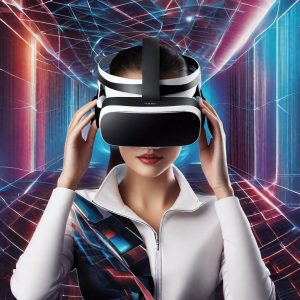
We live in an era when technology is rapidly evolving, with new devices that have never been seen before. The progress has already reached such a significant level that we can create things that 10-15 years ago seemed like they were taken from some science fiction movie.
Virtual reality (abbreviated as VR) and mixed reality (abbreviated as MR) are cutting-edge technologies that are redefining the way we perceive and interact with the world around us. These innovations, although they have appeared not so long ago, have already revolutionized such areas as entertainment, education, medicine, and others.
Let’s start by telling you a bit about VR – it’s a unique technology that creates a digital world in which the user can feel like a full-fledged participant in the virtual world, immersing themselves in this environment. Thanks to specialized glasses and controllers (special consoles), a person can explore virtual spaces designed for various purposes, from entertainment to education.
The main advantage of VR is the possibility of complete immersion. It would be very useful to use it for training, which can be dangerous in real life. For example, pilots, firefighters, and surgeons can train in a virtual environment before taking on real-world tasks. They can all use VR to prepare for real-world tasks without risking their health or life.
Now a little bit about MR, which stands for Mixed Reality. This is a combination of virtual and real reality (meaning the one we see with our own eyes all the time). With mixed reality, the user can see the real world with virtual objects inserted into it. This can be used in a variety of industries, from gaming to complex medical operations, for example.
Thanks to MR, professionals in these different industries will be able to interact with virtual objects directly in the real world. Architects will be able to visualize future buildings right at the construction site, and doctors will be able to use MR to visualize the patient’s internal organs during surgery.
Now both technologies continue to develop very rapidly. Every year they become more realistic, accessible, and user-friendly. There is a high probability that VR and MR will become an integral part of our daily lives in the near future.
It is expected that in the future VR and MR will be used not only for entertainment and training, but also for social interaction. Imagine the opportunity to meet with friends or colleagues from different parts of the world in one virtual space! We will be able to attend virtual concerts or even relax in virtual resorts. Education can also be taken to the next level with VR and MR, allowing students to attend virtual lectures and labs.
Virtual and mixed reality are not just technological novelties. These are powerful tools that are already changing our perception of reality and opening up endless possibilities. They become a bridge between reality and the virtual world, giving us new impressions and experiences, opening up new horizons of possibilities that previously seemed impossible.
So how will virtual reality affect the world over the next few decades, and how will this technology change one of the leading industries?
By 2025-2030, significant changes are expected in the design of VR headsets, which are currently quite large and heavy. Brands are actively working on improving them to make them more attractive and compact. Due to the rapid development of technology, VR headsets are expected to change their appearance to stylish and comfortable ones, like sunglasses. This transformation will significantly reduce their size and make the use of this technology more comfortable, especially for those who experience discomfort with current bulky headsets.
Let’s try to imagine and provide an approximate step-by-step forecast of virtual reality development until 2050, starting in 2023:
2023-2032: The evolution of VR headsets
2023: VR headsets become less bulky and more comfortable to wear, but still require connectivity to powerful computers or consoles.
2025-2030: VR headsets look similar to sunglasses and become popular among users because they can be worn on a daily basis.
2035-2042: Expanding the possibilities of VR
2035: The realism of graphics and audio in VR reaches a high standard, approaching the real world.
2038: The introduction of haptic response technologies allows users to feel different textures and objects in the virtual environment.
2040: VR headsets start using biometric data to customize the virtual experience to the user’s needs.
2045-2050: Changing the way we use VR
2045: VR becomes a standard tool for education and training. Virtual classrooms and simulators are becoming very common.
2047: VR is used in medicine to simulate surgeries and treat phobias.
2050: Virtual reality becomes an integral part of the work and entertainment environment, and finds application in architectural design, engineering, and other industries.
That’s it, this is the scenario we will face in the next 30 years. Still, this forecast cannot be entirely accurate, as it depends on the pace of technological development and other reasons. Given how fast everything is moving forward now, we can expect this to happen even sooner.
But… unfortunately, there is one caveat – at the moment of this date, humanity may face two main choices: to direct its efforts to building a positive and bright future, or to face threats related to the environmental crisis and other global problems that may lead to its complete or partial destruction, and at this point not only the development of technology, but also the development of all humanity itself may stop. We hope for the first option…)

